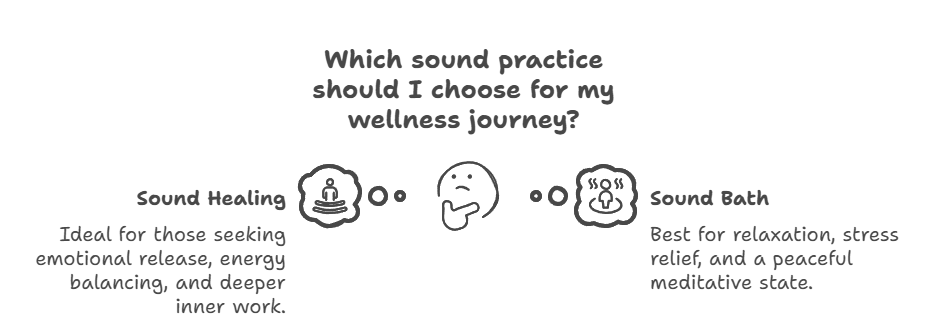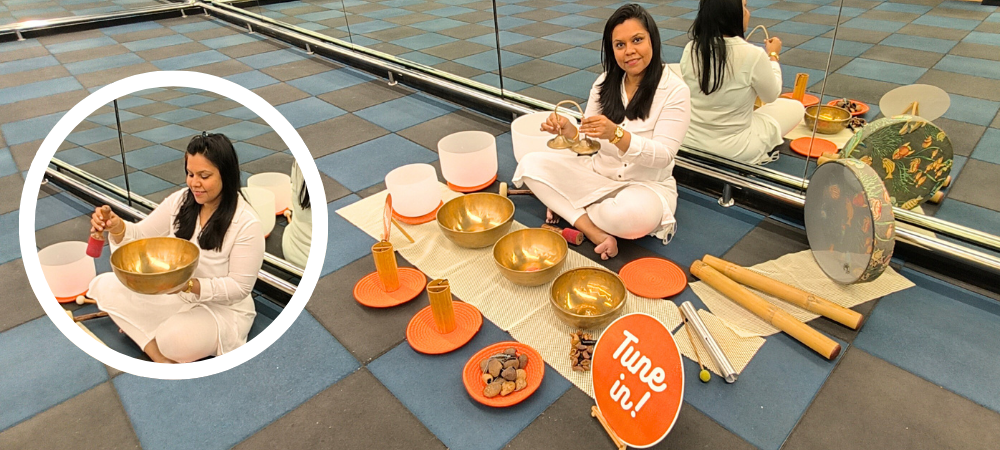As a Wellness Consultant and Sound meditation facilitator, I often get asked a common question: “What’s the difference between sound healing and a sound bath?
Aren’t they the same?”
While both practices use the power of sound to bring calm, clarity, and balance, the approach, intention, and outcomes can be quite different. In this blog, I’d love to share my perspective and experience with both practices to help you understand how they work—and how they can support your wellness journey.
What is Sound Healing?
Sound healing is a therapeutic, targeted practice with a clear intention to help the participant shift or release stuck energy, trauma, or emotional discomfort. It’s not just about relaxation; it’s about transformation. In a sound healing session, I work with specific instruments, frequencies, and even vocal tones to bring energetic balance, release emotional blocks, or soothe physical discomfort.
I often describe it as the ‘therapy’ side of sound – intentional, focused, and often highly intuitive. It involves more active facilitation, sometimes placing instruments near or on the body to direct vibration where it’s needed most. I’ve had clients dealing with grief, anxiety, chronic fatigue, or physical pain who experienced noticeable shifts after sound healing sessions.
Benefits of Sound Healing:
- Emotional release and trauma processing
- Chakra alignment and energy balancing
- Pain relief and physical healing
- Heightened clarity and focus
When to Choose Sound Healing:
- If you’re working through emotional or physical pain
- If you’re seeking clarity or energetic alignment
- If you want to dive deeper than just relaxation
The beauty of a sound bath lies in its simplicity. You just lie down, close your eyes, and allow the sounds to wash over you. Most people find themselves entering deep states of relaxation, and many even fall asleep—something I take as a compliment during my sessions!
From my experience, I’ve seen people enter a sound bath feeling scattered and walk out glowing, calmer, and more grounded. It’s a beautiful way to reset.
Benefits of a Sound Bath:
- Deep relaxation and stress relief
- Emotional release and clarity
- A peaceful meditative state
- Improved sleep
When to Choose a Sound Bath:
- If you’re overwhelmed and need to unwind
- If you’re new to meditation or sound practices
- If you want a safe space to simply rest and restore
Main Differences Between Sound Healing and Sound Bath
Let’s break it down clearly:
| Aspect | Sound Healing | Sound Bath |
|---|---|---|
| Intention | Healing and transformation | Relaxation and rest |
| Method | Interactive and targeted | Passive experience |
| Tools | Includes tuning forks, vocal toning, etc. | Crystal bowls, gongs, chimes |
| Facilitator’s Role | Work with specific areas/issues | Guide the overall space |
In my practice, I often recommend clients begin with sound baths. They’re a gentle, welcoming way to start a sound journey. As one becomes more attuned to the subtle shifts and sensations, deeper sound healing work can then follow.
How They Complement Each Other
Often, I blend both modalities in my sessions. A sound bath helps the nervous system settle, creating a relaxed, receptive state. From that grounded space, we can then move into deeper healing work if the participant is ready.
One memorable experience was working with a woman navigating grief. The initial sound bath allowed her to soften and trust the space. We then moved into sound healing where targeted sounds supported her in expressing and releasing her held emotions. It was gentle, powerful, and incredibly moving.
Choosing Between Sound Healing and Sound Bath
If you’re trying to decide, here’s a quick guide:
Choose Sound Healing if:
- You’re navigating emotional or physical challenges
- You want energetic alignment or chakra balancing
- You’re ready for deeper inner work
Choose a Sound Bath if:
- You need to unwind, de-stress, or sleep better
- You’re new to sound practices
- You simply want to experience a deeply restful state
No matter which you choose, you’re saying yes to self-care and inner connection.
Mindfulness: The Common Thread
Whether I’m facilitating a sound bath or sound healing, mindfulness is always at the heart of it. I guide clients to become present with their body, breath, and emotions.
Mindfulness enhances the sound experience. It invites you to witness your inner world with compassion and awareness. When sound meets mindfulness, healing becomes deeper and more lasting.
Some mindfulness cues I often use during sessions:
- “Notice where in the body you feel the vibration.”
- “Can you anchor your breath to the sound?”
- “What thoughts or emotions arise? Can you let them pass like waves?”

Final Thoughts
Sound healing and sound baths are both beautiful, transformative tools—but they serve different needs. One invites you to rest, the other guides you to release and restore from within.
From my own journey as a mindfulness teacher and sound facilitator, I’ve seen how powerful both can be. Whether you’re lying under a blanket absorbing the tones of a sound bath, or allowing specific frequencies to release old emotional weight in a healing session, the result is the same: a more peaceful, aligned, and vibrant you.












